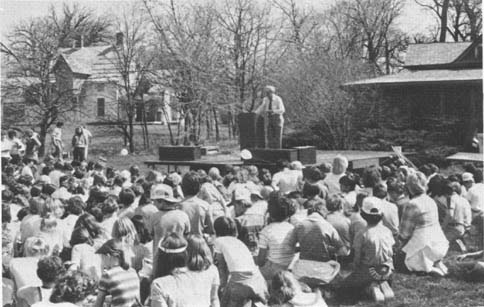 |
Home | Search | Browse | About IPO | Staff | Links |
 |
Home | Search | Browse | About IPO | Staff | Links |
|
Earth Day 1990 By Judy Beck, Commissioner of Glenview Park District April 22, 1990, will mark the 20th anniversary of the original Earth Day. That date in 1970 saw rallies, demonstrations, protests and teach-ins in thousands of communities across the country. Though April 22, 1970, was not the beginning of the environmental movement in the United States, it did serve as a major milestone that resulted in headlines and opinion polls that sent a clear public policy message to State and National leaders—preserve and maintain a healthy environment while repairing past damages. Among the historic events that motivated 1970's Earth Day organizers are: 1962 — Rachel Carson's book, Silent Spring, dramatizes the dangers of pesticides; 1968 — The Cuyahoga River in Ohio catches fire as it flows into Lake Erie; 1969 — A large oil spill covers the scenic beaches of Santa Barbara, California. Our policy makers responded. The U.S. Environmental Protection Agency (U.S. EPA) was formed and the National Environmental Policy Act was passed. Air and water pollution statutes were revamped, and systems to protect and preserve endangered species, wild and scenic rivers, and unique wilderness areas were developed. Federal goals were set to have our nation's rivers and streams fishable and swimmable. Cities were to attain national air quality standards. Millions of federal dollars were passed through state government to the local level to fund park purchases and upgrading of wastewater treatment plants. The results were noticeable. Rivers no longer flamed and foamed, therefore fish populations returned. The scenic views of our national parks were protected from obstructing air pollution. Smaller, but important natural areas, were acquired by local governments. But as we began to measure our progress, we discovered and documented not only the first round of success; but also a new round of problems that presented major challenges. Los Angeles, Denver, and other cities continue to have air unfit for human lungs. The environmental regulatory system worked but suffered from poorly funded agencies and well funded industrial lobbyists and litigants. And then, as if the earth had hired a PR firm, the status of the world's environment hit the headlines with unsettling regularity—2,000 died in Bhopal, India, as the result of a pesticide plant leak, and a nuclear reactor explosion sent radiation across the global atmosphere from Chemobyl, USSR. Yellowstone, the flagship of the national park system, devastated by a major fire and the international voyage of the New York garbage were a regular on the nightly news. The final straw came as millions of gallons of Alaskan crude oil flowed from the wrecked tanker, "Exxon Valdez," and headed for the protected waters, parks and wildlife habitat of one of America's last pristine wilderness areas. The 20th anniversary of Earth Day could not have a better lead-in. Earth Day 1990 takes the big picture agenda and asks simply that everyone "Think Globally, Act Locally." Environmental protection is no longer a spectator sport. As President George Bush urged in September 1989, "Through millions of individual decisions—simple, everyday, personal choices—we are determining the fate of the Earth. So the conclusion is also simple: we're all responsible, and its surprisingly easy to move from being part of the problem to being part of the solution." Begin by making an Earth Day resolution to respect the Earth and instill this value in all you can influence. Next implement this ideal by softening your impact on the environment: reduce energy usage at home—insulate, caulk, light a work space not a room; adopt a "no growth" policy for the number of miles your family cars travel every week and look for transportation options like carpools or biking; work to make recycling easy by promoting curbside pickup of materials for your community; look for recycling content when making consumer choices. Plan a garden that includes composting and native plantings that provide habitat for wildlife; inventory the natural areas in your community and determine if any need to be preserved; and most important of all, take time to enjoy the parks in your own community.

Fourth and Fifth Graders participated in the Grove National Historic Landmark/ Glenview Park District's 1980 Earth Day. (Photograph provided by Stephan Swanson, Director of the Grove National Historic Landmark.)
|
|
|